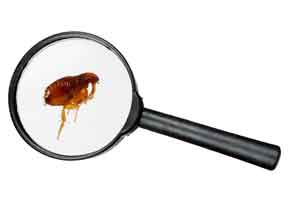Winter Flea Alert!
Fleas thrive in warm weather conditions with a preference for shaded and moist areas. Although cooler temperatures are now forecasted over the coming months for many ADC locations, fleas continue their agenda of seeking out a meal on a warm-blooded animal.
An adult flea lays an average of 27 eggs per day and over the course of several months, that total can reach 500 – 600 eggs. Flea eggs are not sticky and they usually fall off the host onto furniture, floors and outdoors. These eggs may lie dormant for weeks waiting for the right conditions to hatch. A vacant house with flea eggs may “bloom” with fleas when residents move in.
With flea activity comparatively low now, use this period to thoroughly wash pets’ bedding, vacuum under furniture and paying attention to baseboards and any crevices where flea eggs may have fallen. A little effort now will help break the flea cycle when the weather warms.

Did you know…?
A flea might live a year and a half under ideal conditions. These include the right temperature, food supply, and humidity. Generally speaking, though, an adult flea only lives for 2 or 3 months. Without a host for food, a flea’s life might be as short as a few days. But with ample food supply, the adult flea will often live up to 100 days.
Low Humidity Weather
Increases Allergic Itching
Dry itchy skin is a frequent condition that some people experience during winter. Low humidity and heated buildings affect the surface moisture of our skin resulting in dry, scaly and itchy skin. For an allergic pet, low humidity compounds their problem of their itchy skin.
The skin provides a physical and chemical barrier to the environment and the inside tissues of the body. This barrier is responsible for keeping “the good stuff” in and the “bad stuff” out! In the case of the skin the good stuff is water. Our skin is a well hydrated organ and retaining moisture in the skin is critical for normal function. The “bad stuff” are the normal resident yeasts and bacteria on the skin as well as the floating environmental pollens that our patients are exposed to. For an allergic pet,this barrier is impaired and they are already dealing with an less than optimal barrier function. . Low humidity for some pets may promote dry skin and increasing the itch level by allowing moisture to evaporate from the skin. Scratching and chewing (or licking) leads to damaged skin and allows breaks in the barrier allowing for increased pollen absorption compounding the allergic patient’s exposure to substances triggering their allergies and itching.
Most pet owners are aware of their pets’ itch level; often it is to the inconvenience of the owner when they recognize their pet’s excessive scratching. In the middle of the night, the jingling of the collar or in the evening the cat drowning out the TV by constantly licking and grooming due to itchiness can be a particular source of consternation!
If your pet is already being treated for allergies, ask your veterinarian if there are additional steps to be taken to help your pet during low humidity conditions and protect the barrier of the skin. Managing allergic skin disease is generally a multi-pronged approach and keeping a healthy barrier is a major part of the best allergic management.
One of the allergens that appear frequently in allergy tests at Animal Dermatology Clinic is dust mites. Humans are also affected and mites are a leading cause of asthma and allergies. Without exception, dust mites are present in every home!
Dust mites cannot be seen with the naked eye, but with the aid of a microscope (or at least 10x magnification) they can be found on pillows, mattresses, furniture and rugs. Most certainly, their favored location is bedding because of the moisture contact of skin and the ample food source. Mites feed on the dead skin cells we slough off, so the bed is a virtual 24-hour buffet! It is their fecal pellets and body fragments that contain the bothersome allergen.
Tips to Keep Mites to a Minimum in the Home
During the winter our houses are usually closed, humidifiers are used to combat dry air and bedding warmth increases, all conditions that help dust mites thrive. There are many strategies to reduce your exposure to house dust mites and certainly for allergic people and pets these tips from the American Lung Association may help:
• Reduce humidity. To minimize growth of dust mites, keep your home below 50 percent humidity. In humid areas, air conditioning and dehumidifiers can help achieve this goal. On dry days, opening windows for one hour per day will help remove humidity from the house.
• Target the places where dust mites can thrive. Reduce furniture or use furniture with smooth surfaces, eliminate drapes and curtains, and cover mattresses and pillows to reduce dust mites. Wash bedding in hot water once a week.
• Replace carpets. Carpeting should be removed from the home, especially if occupants are allergic to dust mites. If this is not possible, chemical cleaning of carpets with benzyl benzoate may reduce dust mites.
• Damp mop floors often. If you must retain the carpet, use a vacuum cleaner with a high efficiency filter or a central vacuum cleaner. When dusting, use a damp mop or damp cloth to reduce the amount of dust stirred up when cleaning.
 Dr. Ashley (Stich) Bourgeois Achieves Diplomate Status
Dr. Ashley (Stich) Bourgeois Achieves Diplomate Status
It has been quite an eventful year for Dr. Ashley Bourgeois. In November she successfully completed her certifying board examinations and became a Diplomate of the American College of Veterinary Dermatology. In this unique and specialized field of veterinary medicine, there are fewer than three hundred boarded veterinary dermatologists in the United States.
Dr. Bourgeois graduated from the University of Missouri’s College of Veterinary Medicine in 2010. She then completed a one-year small animal internship at Purdue University. Upon finishing her internship, she accepted a residency position with Animal Dermatology Clinic-Tustin in 2011. Dr. Bourgeois became interested in dermatology during her first year of veterinary school and during her residency has developed a strong interest in autoimmune and infectious skin diseases. Dr. Bourgeois is now on staff as one of the board certified dermatologists at ADC-Tustin.
In addition in 2014, Dr. Bourgeois exchanged nuptials with her fiancé Jeff and have settled in Orange, CA along with an energetic terrier mix named “Darby.”
 Dr. Ashley (Stich) Bourgeois Achieves Diplomate Status
Dr. Ashley (Stich) Bourgeois Achieves Diplomate Status
